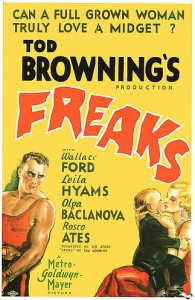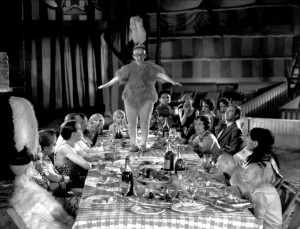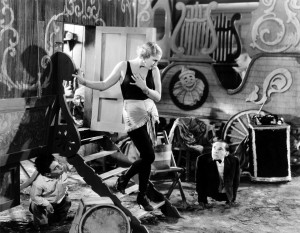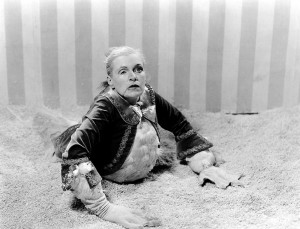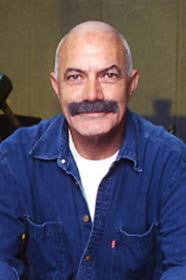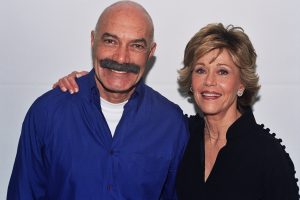A landmark movie that could only have been made in the Pre-Code era, Tod Browning’s Freaks is one of the most horrifying and horrific features to have ever been made in Hollywood’s history!
Our Grade: A (***** out of *****)
One of the film’s original ads quoted Louella Parsons, the syndicated gossip journalist, claiming, “for pure sensationalism, ‘Freaks’ tops any picture yet produced.” She might have reacted to the tag line on the poster, “Can a full grown woman truly love a midget?” (See above photo)
Only 64 minutes long, Freaks is one of the two or three scariest films I have ever seen; Diabolique, made by Gallic director Clouzot, is the other one.
“Give me something that will out-horror Frankenstein,” asked Irving Thalberg, MGM’s head of MGM production from his director, Tod Browning. MGM wanted to compete with Universal, a studio which had established a near monopoly on the horror genre in the early 1930s with its Frankenstein and Dracula movies.
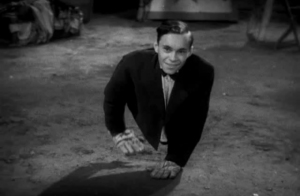 Thalberg got more than he had bargained for. Reportedly, Thalberg was so utterly shocked when he saw Browning’s version, thhat he had to over fight and come great opposition among the top brass to release the film.
Thalberg got more than he had bargained for. Reportedly, Thalberg was so utterly shocked when he saw Browning’s version, thhat he had to over fight and come great opposition among the top brass to release the film.
The film is directed and produced by Tod Browning, whose career had never recovered from it. Browning had left his rich family to join a traveling circus; he drew on his personal experiences for Freaks. The success of Dracula gave him considerable leeway to make a horror film. Here is a film that could not have been made afte 1934, when the Production Code was enforced.
Browning reversed the conventional formula: He showed the physically deformed “freaks” as decent and honorable people, and the “normal” members of the circus as the real villainous monsters, who conspire to murder a performer in order to get his inheritance.
Living up to its title, Freaks displayed dwarfs, human torso, and other monsters that up until then were seen, if at all, only in circuses and carnivals.
Plot
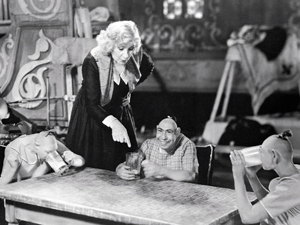 The story follows Cleopatra (Olga Baclanova), a beautiful but avaricious trapeze artist who seduces and marries midget circus owner Hans (Garry Earles) to get at his money. Her secret lover is Hercules (Henry Victor), the strongman who howls with laughter.
The story follows Cleopatra (Olga Baclanova), a beautiful but avaricious trapeze artist who seduces and marries midget circus owner Hans (Garry Earles) to get at his money. Her secret lover is Hercules (Henry Victor), the strongman who howls with laughter.
In one of the film’s most memorable moments, the close-knit society of freaks warmly welcomes her into their family at the wedding reception as “one of us, one of us.” Cleopatra reacts with disgust, however, telling the midgets that she will never be grotesque
She humiliates her smitten hubby by openly kissing the lecherous Hercules, and the community soon realizes a threat in their presence. When Hans falls ill, the group figures out that Cleopatra and Hercules have been slowly poisoning him, and they plan a horrible, ironic revenge.
Though the suspenseful, brilliantly handled final scenes suggest an exploitation of the film’s handicapped players, by then, we have come to identify with them more than with the “normal” figures. The final revenge is therefore not so much an attempt to turn melodrama into horror as it is the resolution of a morality play.
 Browning’s chronicle depicts in graphic details how severely physically deformed people manage on their own, and even form sort of a community based on friendship and trust.
Browning’s chronicle depicts in graphic details how severely physically deformed people manage on their own, and even form sort of a community based on friendship and trust.
We see how they bond to each other, in small and large cliques, and how they relate to those who love and accept them as they are.
The tale begins with a sideshow barker drawing customers. A woman then looks into a box and screams upon viewing a hidden occupant, who, as the barker explains, was once a beautiful trapeze artist named Cleopatra.
Cleopatra seduces and then marries sideshow midget Hans after learning of his wealth. She then conspires with the circus strongman Hercules to get rid of Hans; at their wedding, Cleopatra poisons Hans’ wine. The other “freaks” are forced to accept Cleopatra, holding an initiation rite in which they pass a wine goblet while chanting, “We accept her, we accept her. One of us, one of us. Gooba-gobble, gooba-gobble.”
The ceremony frightens Cleopatra, who, drunken, reveals her affair with Hercules. Mocking the freaks, she tosses the wine in their faces, and drives them away. Hans, humiliated, realizes he’s been played for a fool and rejects Cleopatra’s apology before falling ill from the poison.
Bedridden, Hans pretends to be taking the poisoned medicine Cleopatra has been giving him, but he secretly plots with the other freaks a merciless revenge scheme to strike back at Cleopatra and Hercules.
In the film’s horrific climax, the freaks attack the evil pair during a storm, using guns, knives, and other sharp-edged weapons. Hercules is not seen again (the original ending had the freaks castrating him; he is seen singing in falsetto). Cleopatra, now a grotesque, is a squawking “human duck”—her deformed hands look like duck feet and her lower half is tarred and feathered.
MGM later imposed a phony, happier ending, which showed Hans living as a millionaire. Venus and her clown boyfriend Phroso visit, bringing Frieda, to whom Hans had been engaged before meeting Cleopatra.
After accusations of vulgarity, tastelessness, and exploitation, MGM resorted to the original–and more coherent–conclusion, which shows Cleopatra as a freak. This is followed by a brief finale, in which Frieda comforts crying Hans in her arms, reaffirming her long-lasting love for him.
There was public revulsion concerning the use of actual freaks. However, Dwain Esper (of Maniac fame) later gave it road shows in tents and burlesque houses, further adding to the reputation of this cult classic.
But ultimately, it’s not the nominal plot that matters–or makes the story powerful. It’s the “slice of life” segments, detailing the sideshow performers, which makes the movie scary.
Take, for example, the sequence of the Bearded Woman, who loves the Human Skeleton, gives birth to their daughter. The news is spread among the friends and colleagues by The Stork Woman (Elizabeth Green).
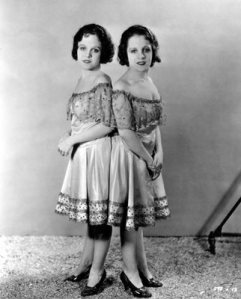 Violet, a conjoined twin whose sister Daisy is married to a clown, becomes engaged to the circus’ owner. The sisters experience each other’s physical sensations: Daisy is romantically intrigued, when Violet’s fiancé kisses her, and a closed-eyed Violet knows when Daisy’s shoulder is touched.
Violet, a conjoined twin whose sister Daisy is married to a clown, becomes engaged to the circus’ owner. The sisters experience each other’s physical sensations: Daisy is romantically intrigued, when Violet’s fiancé kisses her, and a closed-eyed Violet knows when Daisy’s shoulder is touched.
The two sisters were played by real-life conjoined twins Daisy and Violet Hilton. The Human Torso (Prince Randian) rolls and then lights his own cigarette, while using only his mouth.
After a preview in San Diego, during which some spectators left the screening in protest (and disgust), while others screamed at the end demanding their money back, the film was drastically cut and later completely shelved.
There has been a debate to what extent the film was sympathetic or exploitative toward its “freak” characters. I side with those who see this unusual feature as a plea for greater sensitivity for the creatures, who stand in for all those labeled as “Others” by dominant ideology and mainstream culture.
But you have to watch it for yourself.
Nine decades after it was made, Freaks is still a shocking feature, which resonates strongly, and a marvel that it came out of MGM, the most mainstream and “sunniest” of all Hollywood studios.
Cast
Wallace Ford as Phroso
Leila Hyams as Venus
Harry Earles as Hans
Daisy Earles as Frieda
Rose Dione as Madame Tetrallini
Daisy and Violet Hilton as the Siamese twins
Schlitzie as himself
Olga Baclanova as Cleopatra
Roscoe Ates as Roscoe
Henry Victor as Hercules
Josephine Joseph as Half Woman-Half Man
Johnny Eck as Half Boy
Frances O’Connor as Armless girl
Peter Robinson as Human skeleton
Olga Roderick as Bearded lady
Koo Koo as herself
Prince Randian as The Living Tor
Martha Morris as Angeleno’s armless wife
Elvira Snow as Pinhead Pip
Jenny Lee Snow as Pinhead Zip
Elizabeth Green as Bird Girl
Delmo Fritz as Sword Swallower
Angelo Rossitto as Angeleno
Edward Brophy and Matt McHugh as the Rollo Brothers.
Credits
Produced and directed by Tod Browning (Irving Thlaberg, uncredited)
Screenplay: Willis Goldbeck, Leon Gordon, Edgar Allan Woolf, Al Boasberg, based on the short story “Spurs,” by Clarence Aaron “Tod” Robbins
Cinematography: Merritt B. Gerstad
Edited by Basil Wrangell
Production and Distribution: MGM
Release date: February 12, 1932
Running time: 64 minutes
DVD
Warner DVD, part of a collection of classic horror pictures that also includes “The Bad Seed,” “Dead Ringers,” and other titles.
